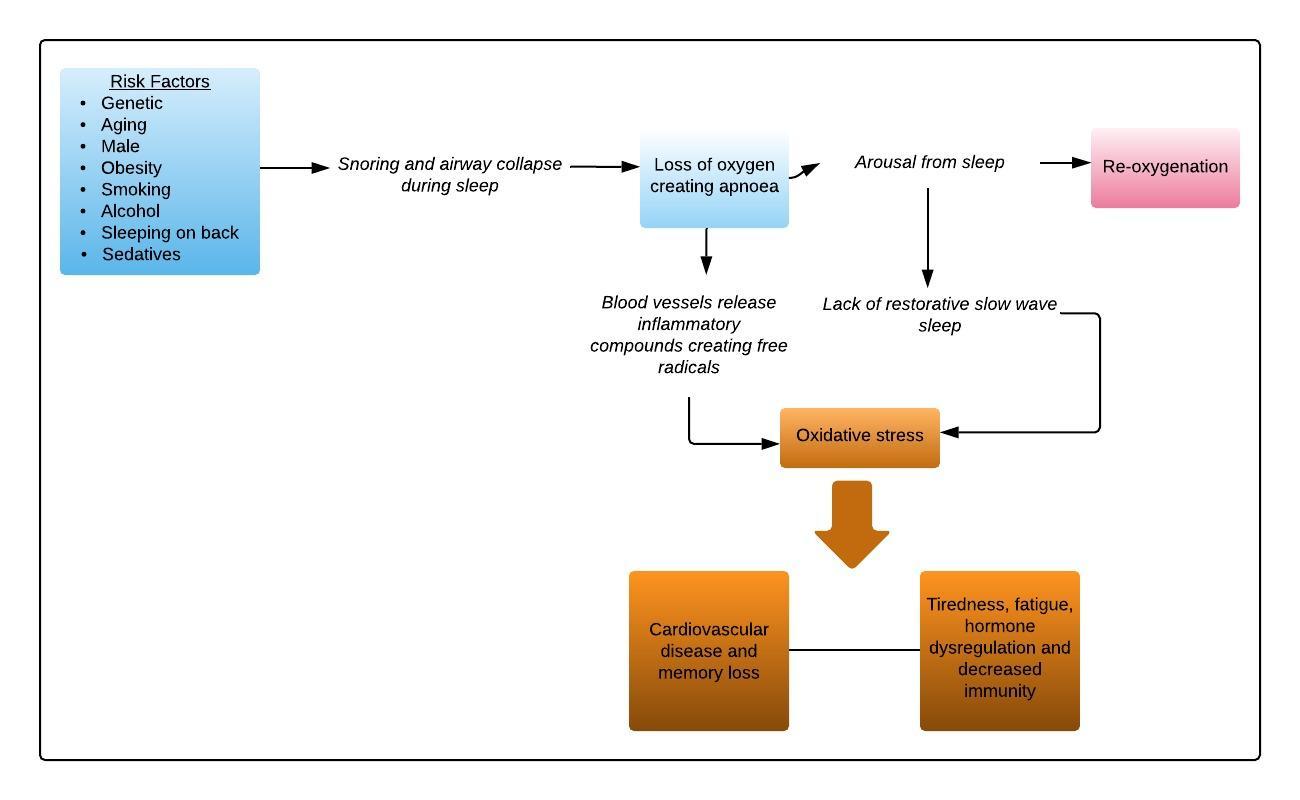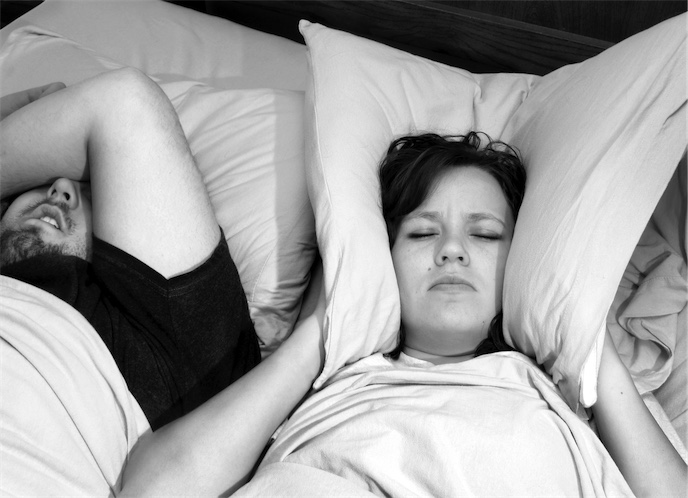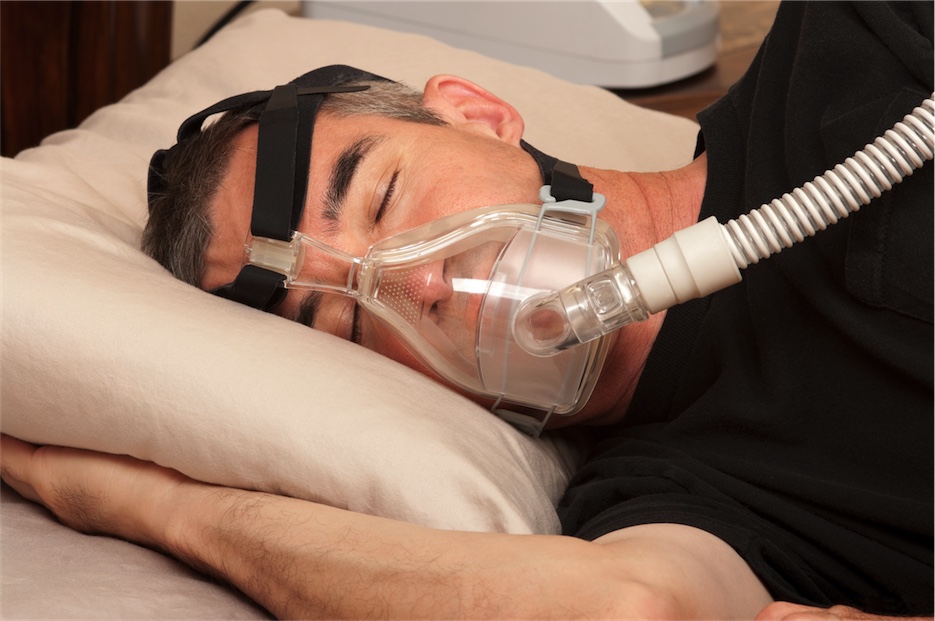Restless sleep. Loud snoring. Daytime sleepiness. Fatigue. Poor concentration. These are a few of the primary symptoms of obstructive sleep apnoea 1. This sleep disorder is estimated to affect up to 30% of the Western adult population, however, less than 5% are diagnosed and treated 2. Secondary symptoms that may be seen with the primary symptoms include morning headaches, anxiety, high blood pressure, obesity and poor immunity 3.
What is obstructive sleep apnoea?
Obstructive sleep apnoea occurs when the muscles responsible for keeping the upper airway open during sleep narrow or collapse. This causes a decrease in oxygen and a corresponding increase in carbon dioxide in your blood, which in turn triggers the nervous system to rouse you from sleep so you start breathing again. These “apnoeas” (pause of breath) can occur between 5 (mild) – 100 (severe) times per hour. The repetitive loss of oxygen followed by re-oxygenation promotes the production of inflammatory molecules creating oxidative stress that reduces the ability of your blood vessels to dilate by up to 50% 3.
Oxidative stress from reactive oxygen species then creates an on-going feedback loop as they contribute to decreased tone in the upper airway muscles making them even more likely to collapse 4,5.
The constant arousal from sleep means that less restorative

Pathophysiology of sleep apnoea
Health consequences
Obstructive sleep apnoea has
The risk of cardiovascular disease is doubled. This is due to the inflammation and oxidative stress on the blood vessels creating an environment
The lack of restorative
Did you know? People who suffer from obstructive sleep apnoea are 4-9 times more likely to be involved in a motor vehicle accident 8.
The lack of
Oxygen deprivation in obstructive sleep apnoea has also been found to adversely affect neurons in the hippocampus. This is the part of the brain responsible for transforming short term memories into long term memories 10.
Risk factors for obstructive sleep apnoea
- Aging: more common in middle and old age
- Male sex: obstructive sleep apnoea affects up to 25% of
middle aged men compared to 9% of women - Genetic: you are 2-3 times more likely to suffer from this if there is a family history.
- Overweight or obese
- Thick neck circumference
- Smoking: creates more oxidative stress and depletes antioxidants
- Alcohol consumption: relaxes airway muscles
- Use of sedatives as they also relax airway muscles
Did you know? Pre-menopausal women are less likely to suffer from obstructive sleep apnoea than men due to the
Treatment
The most widely used treatment is continuous positive airway pressure (CPAP). This involves wearing a face-mask attached to a small pump which provides constant pressure to keep the airways open. While there is good evidence for the effectiveness of this treatment some people are constrained by the cost of the machine or dislike wearing the mask
The role of nutritional supplements
While nutritional therapy can’t keep the airways open it can reduce the dependency on CPAP especially in mild to moderate cases.
Anti-oxidant nutrients in various trials have been shown to be of benefit in reducing both the symptoms and consequences of obstructive sleep apnoea.
Vitamin C is probably one of the most well known and
Vitamin E has also shown benefits in obstructive sleep apnoea working on a similar fashion to Vitamin C and when combined these two antioxidants reduced snoring and daytime sleepiness 2,10.
N-acetylcysteine (NAC) is a building block for one of the body’s most powerful antioxidants, glutathione, which has the ability to reduce free radicals in the body 13. A small, 2011, double-blinded,
Lifestyle Tips
- A healthy diet high in antioxidant fruits and vegetables and plenty of water
- Avoid or minimize processed food, refined sugar
and alcohol - Regular exercise to maintain a healthy body weight
- Cessation of smoking
- Sleep on your side rather than your back as this creates less resistance on the upper airway muscles.
- Exercises adapted from traditional speech therapy for the upper airways may also provide benefit.
Recommendations
If you suspect you may be suffering from obstructive sleep apnoea:
- Speak to your health care practitioner and arrange to get tested.
- Consider CPAP especially if your obstructive sleep apnoea is severe.
- In conjunction with a healthy diet and regular exercise, speak to your natural healthcare provider about adding in some antioxidant supplements that are appropriate for your individual circumstances.
If you enjoyed this you may also like:
Why sleep needs to be a part of your weight loss strategy
References:
- Eckert DJ, Malhotra A. Pathophysiology of adult obstructive sleep apnea. Proc Am Thorac Soc. 2008;5(2):144–53.
doi :10.1513/pats.200707-114MG. - Sadasivam K,
Patial K, Vijayan VK, Ravi K. Anti-oxidant treatment in obstructive sleep apnoea syndrome. Indian J Chest Dis Allied Sci. 2011;53(3):153–62. Available at: http://medind.nic.in/iae/t11/i3/iaet11i3p153.pdf. Accessed January 10, 2016. - Atkeson a, Jelic S. Mechanisms of endothelial dysfunction in obstructive sleep apnea. Vasc Health Risk Manag. 2008;4(6):1327–1335. Available at: papers://2e21e073-9ccd-431c-9795-22d005492126/Paper/p5516. Accessed January 12, 2016.
- Hatipoğlu U, Rubinstein I. Inflammation and obstructive sleep apnea syndrome pathogenesis: a working hypothesis. Respiration. 2004;70(6):665–71.
doi :75218. - Veasey SC, Zhan G, Fenik P, Pratico D. Long-Term Intermittent Hypoxia. Am J Respir Crit Care Med. 2004;170(6):665–672.
doi :10.1164/rccm.200403-261OC. - Lavie L, Vishnevsky A, Lavie P. Evidence for lipid peroxidation in obstructive sleep apnea. Sleep. 2004;27(1):123–8. Available at: http://www.ncbi.nlm.nih.gov/pubmed/14998248. Accessed January 10, 2016.
- Eisele H-J, Markart P, Schulz R. Obstructive Sleep Apnea, Oxidative Stress, and Cardiovascular Disease: Evidence from Human Studies. Oxid Med Cell Longev. 2015;2015:608438.
doi :10.1155/2015/608438. - Snore Australia. Obstructive Sleep Apnoea. 2016.
Macrea M, Martin T, Zagrean L, Jia Z, Misra H. Role of leptin asantioxidant in obstructive sleep apnea: an in vitro study using electron paramagnetic resonance method. Sleep Breath. 2013;17(1):105–110.doi :10.1007/s11325-012-0656-8.- Baldwin CM, Bootzin RR, Schwenke DC, Quan SF. Antioxidant nutrient intake and supplements as potential moderators of cognitive decline and cardiovascular disease in obstructive sleep apnea. Sleep Med Rev. 2005;9(6):459–476.
doi :10.1016/j.smrv.2005.04.004. - Andersen ML, Bittencourt LRA, Antunes IB, Tufik S. Effects of progesterone on sleep: a possible pharmacological treatment for sleep-breathing disorders? Curr Med Chem. 2006;13(29):3575–82. Available at: http://www.ncbi.nlm.nih.gov/pubmed/17168724. Accessed January 14, 2016.
- Grebe M, Eisele HJ, Weissmann N, et al. Antioxidant vitamin C improves endothelial function in obstructive sleep apnea. Am J Respir Crit Care Med. 2006;173(C):897–901.
doi :10.1164/rccm.200508-1223OC. - Gropper S, Smith J, Groff J. Advanced Nutrition and Human Metabolism. 5th ed. Canada: Wadsworth Cengage Learning; 2009.

Need help with your sleep apnoea?
Norelle Hentschel is an experienced Naturopath with a clinic in Stones Corner, Brisbane who enjoys supporting her clients to reach their health goals.
Want more articles like this?
Receive a monthly digest of natural health information to help you become “health” sufficient!
PS. Your inbox real estate is precious, and we will never annoy you with sales pitches or share your details with anyone else. One email a month — that’s it.


